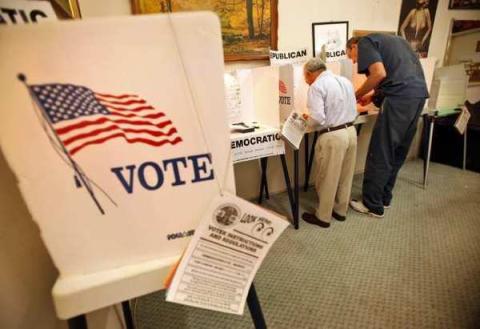While democracy was forming in the colonies, the Old World ideology that it was nothing short of mob rule was held strongly by many prominent colonists, thereby limiting voting rights to citizens who were white, male, and either owned property or paid substantial taxes.
On May 29, 1790, the last state, Rhode Island, voted to ratify the Constitution leaving voting rights up to individual states. Still reflecting the values and restrictions of our early European roots, voting rights continued to be limited to white, male, property owners, except in Delaware, Maryland, Massachusetts, New Hampshire and New York, the only states which permitted "citizens of colour" voting rights.
The American Revolution was brought about in part over liberty, taxation and religious freedom, so it seems odd and even contradictory that a country presumably founded on these values maintained not only racial and wealth restrictions, but also religious prerequisites related to voting rights. In particular, Catholics and Jews were not permitted to vote until 1810.
“Many colonies and states imposed other restrictions on voting, including religious tests. Catholics were barred from voting in five colonies and Jews in four.” - Steven Mintz; Winning the Vote: A History of Voting RightsIn 1848, as a result of the Mexican-American War, citizenship was granted to those living in territories gained from Mexico, and while the new citizens gained voting rights, they were aggressively and violently intimidated and the English language was used as a tool to restrict their participation in elections.
Connecticut and Massachusetts began requiring voters to take literacy tests in 1855. Initially used to discriminate against Irish-Catholic immigrants, it gained notoriety as other states, particularly in the South, employed the practice as late as 1964.
By 1856, almost all white males could vote as states lifted property ownership and taxation as a prerequisite, but females and Native Americans would have to wait another 64 years to be granted voices at the polls.
The infamous Dred Scott v Sandford decision of 1856 handed a severe blow to slaves and, although Justice Benjamin R. Curtis provided a lengthy history of the black vote in the US, the Supreme Court decision against Scott set the stage for continued voting restrictions.
General Lee’s surrender on April 9, 1865 brought to an end the American Civil War and an “official” end to slavery, but little changed for the newly “freed slaves” with deep-seated hatred and resentment rampant throughout the South. As the 15th Amendment gave former slaves voting rights in the US in 1870, southern states began adopting tactics of extreme violence, intimidation, and literacy tests that were literally impossible to pass, effectively eliminating the black vote.
Potential voters had ten minutes to complete the test and failure is answering any one of the 43 questions incorrectly. Other southern states including Alabama and Mississippi utilized the same method to thwart voter rights and if that wasn't enough to accomplish the goal, states such as Florida began to reinstate poll taxes to disenfranchise the black and poor vote in 1899.
The 20th Century saw voting rights begin to change significantly, especially in the 1960s and 1970s. In 1920 and 1924 women and Native Americans were finally granted voting rights.
1944: SCOTUS outlaws a practice which could still be interpreted today as exclusionary toward nonpartisan voters in Smith v Allwright, the “white primaries,” a practice with obvious goals.
The Supreme Court held that:
“The United States is a constitutional democracy. Its organic law grants to all citizens a right to participate in the choice of elected officials without restriction by any state because of race. This grant to the people of the opportunity for choice is not to be nullified by a state through casting its electoral process in a form which permits a private organization to practice racial discrimination in the election.”
1957: SCOTUS implements the Civil Rights Act which, among other serious issues, finally enforces the 15th Amendment by establishing the Civil Rights Commission to investigate illegal discriminatory voting practices, giving the 1960's a forward momentum seen neither before nor since in voter rights.
1960: Another SCOTUS decision with implications today, Gomillion v. Lightfoot which outlawed gerrymandering as a means to manipulate the black population of Tuskegee, Alabama out of voting in city elections. However, the ruling is considered somewhat vague, giving political parties a means by which they continue using gerrymandering as a practice to manipulate voter demographics.
1961: The 23rd Amendment grants voters of the District of Columbia the right to vote in presidential elections.
1964: The 24th Amendment abolishes all poll taxes in the US.
1965: The Voting Rights Act outlawed discriminatory election practices including literacy tests and other means of discriminatory voting behavior on the part of any state, significantly changing the relationship between states and the federal government and was upheld again in 1966 in South Carolina v. Katzenbach as was the illegal use of literacy tests again in Oregon v. Mitchell in 1970.
1971: The 26th Amendment sets the minimum voting age at 18. Prior to this amendment, the minimum age was 21, adding substantial fuel to anti-war protesters protesting the war in Vietnam; “we can die for our country, but we can’t vote.”
Worrisome developments and voter apathy in the 21st Century have begun to erode many of the accomplishments made in the 20th Century. Gerrymandering is considered not only acceptable, but “essential” in preserving partisanship by the Democrats and GOP.
Likewise, 2010 through 2013 saw voter registration laws under attack in several southern states again including Florida, South Carolina, and Texas. This includes the recent SCOTUS decision, Shelby County v. Holder wherein Shelby County, Alabama, a region notorious for voter rights abuses prior to 1965, was successful in removing a key provision of the VRA.
